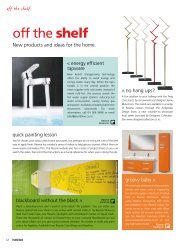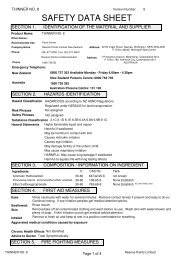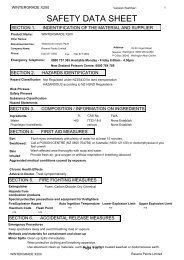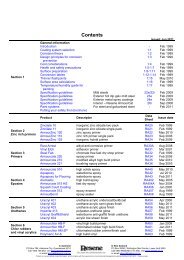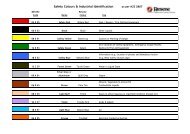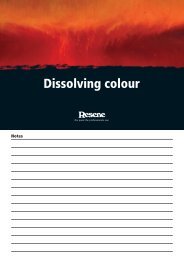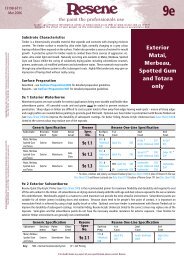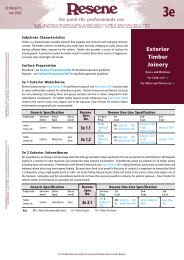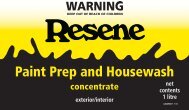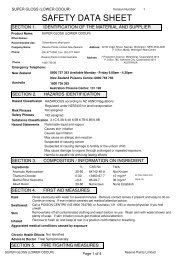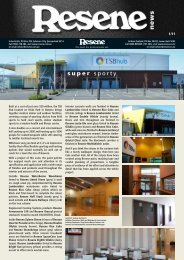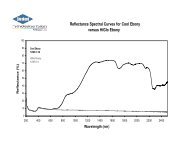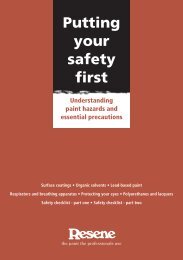d814 - Resene Timber Surface Prep
d814 - Resene Timber Surface Prep
d814 - Resene Timber Surface Prep
Create successful ePaper yourself
Turn your PDF publications into a flip-book with our unique Google optimized e-Paper software.
May 2009D814<strong>Resene</strong><strong>Timber</strong><strong>Surface</strong> <strong>Prep</strong><strong>Resene</strong> <strong>Timber</strong> <strong>Surface</strong> <strong>Prep</strong> is alow VOC pigmented high buildwaterborne surfacer for solidtimber. Used to upgrade and fillsurface defects in solid timbersubstrates prior to application ofwaterborne finishing systems.exterior/interiorVehicle typePigmentationSolventFinishColourDry time (minimum)Dry to sand (minimum)Recoat time (minimum)Primer requiredTheoretical coverageDry film thicknessUsual number of coatsAbrasion resistanceChemical resistanceSolvent resistanceDurabilityThinning and clean upVOCPhysical propertiesAcrylic emulsionInorganic pigments and extendersWaterLow sheenOff white40 minutes (film build dependent)2 hours (film build dependent)4 hours (film build dependent)Pine: No. Cedar: Yes.2 sq. metres per litre230 microns at 2 sq. metres per litre1-2 (dependent upon depth of substrate defect)Fair (sandable)Depends upon topcoat systemDepends upon topcoat systemExcellent when sealed and topcoatedWater1 gram per litre (see <strong>Resene</strong> VOC Summary)Typical uses• Finger jointed pine• Open grained timber• <strong>Timber</strong> weatherboards• WindowsillsPerformance and limitationsPerformance 1. Good adhesion to prepared solid timbersubstrates.2. Excellent filling properties.3. Sandable.4. High build.5. Low porosity.6. Low VOC.7. An Environmental Choice approved product.Limitations 1. Not designed to fill major cracks orimperfections2. Low elasticity3. Not designed to block waterborne stains4. <strong>Resene</strong> <strong>Timber</strong> <strong>Surface</strong> <strong>Prep</strong> is designed to beovercoated with <strong>Resene</strong> waterborne primers/finishes.5. Do not apply at temperatures below 10ºC orwhen it is liable to drop below 10ºC during thedrying period.Please ensure the current Data Sheetand Safety Data Sheet are consultedprior to specification or application ofproduct. If in doubt contact <strong>Resene</strong>.
<strong>Timber</strong> <strong>Surface</strong> <strong>Prep</strong><strong>Surface</strong> preparation<strong>Timber</strong>Clean down thoroughly to remove all dirt, dust, and loose material such as chalked paint (for an existingpainted surface clean using <strong>Resene</strong> Paint <strong>Prep</strong> and Housewash (see Data Sheet D812).Ensure surface is free from oil, grease and mould. If moss and mould are present, treat with <strong>Resene</strong> Moss &Mould Killer (see Data Sheet D80). Scrub cracked areas with a stiff bristled brush while wet followingapplication of <strong>Resene</strong> Moss & Mould Killer (see Data Sheet D80). Rinse off with fresh water.Sanding is not normally required for new timber, but weathered timber or flaking areas on existing paintedtimber must be thoroughly sanded using 120 grit sandpaper to remove loosely adhering paint and degradedtimber fibres. Feather back flaking areas to a sound edge, dust off. Apply <strong>Resene</strong> <strong>Timber</strong> <strong>Surface</strong> <strong>Prep</strong>.Note for Cedar prime bare prepared areas with <strong>Resene</strong> Wood Primer (see Data Sheet D40). Allow primer tocure for recommended time before applying <strong>Resene</strong> <strong>Timber</strong> <strong>Surface</strong> <strong>Prep</strong>.Following surfacing, any remaining areas of bare timber must be primed with recommended primer prior toapplication of topcoats.Sanding dust from old lead or chromate based paints or old building material containing asbestos may beinjurious to health if inhaled or ingested. Seek expert advice if the presence of these materials is suspected.ApplicationDo not thin as this reduces application thickness and may necessitate application of additional material.Apply then lay off to reduce brush marking in dry film.Allow <strong>Resene</strong> <strong>Timber</strong> <strong>Surface</strong> <strong>Prep</strong> to dry for the recommended time then sand to a smooth finish using180-220 grit sandpaper, dust off or thoroughly wipe with a damp cloth. Seal surfaced areas with <strong>Resene</strong>Quick Dry waterborne primer undercoat (see Data Sheet D45).Precautions1. Cold damp conditions will retard curing.2. Breathing of sanding dust should be avoided and wearing of a tight fitting dust mask during sanding isrecommended.Please ensure the current Data Sheet is consulted prior to specification or application of <strong>Resene</strong> products.If the surface you propose to coat is not referred to by this Data Sheet, please contact <strong>Resene</strong> for clarification.In AustraliaPO Box 785, Ashmore City, Queensland 4214Call 1800 738 383, visit www.resene.com.auor email advice@resene.com.auIn New ZealandPO Box 38242, Wellington Mail Centre, Lower Hutt 5045Call 0800 RESENE (737 363), visit www.resene.co.nzor email advice@resene.co.nzPrinted on environmentally responsible paper, which complies with the requirements of environmental management systems EMAS and ISO14001. Please recycle.



